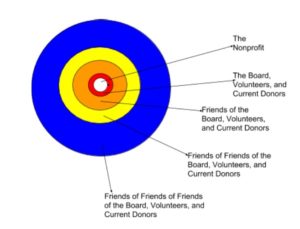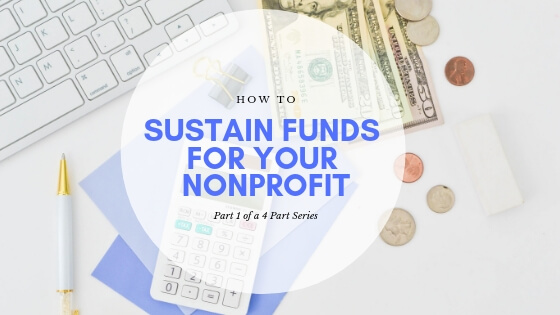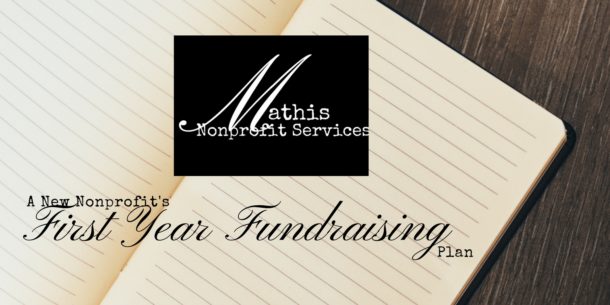Sustaining your nonprofit over the long haul is difficult unless you establish a donor funnel. It will direct your fundraising activities and help you sustain funds. Donor funnels are how you move your prospects (business world calls them leads) to donors. There are four parts to a donor funnel: prospecting, cultivating, asking, and stewarding. One thing that you must remember when moving people through a funnel is that people give based on relationships with the organization or someone in the organization. This one action- having a funnel- will increase your donations and sustain your funding. This is part one of a four part series where we will go in depth into each stage of the donor funnel.
Prospecting- Stage One of the Donor Funnel
Prospecting is all the activities performed to gain new donors. It is the first step in the relationship and on the road to sustain funds. New nonprofits will spend the most amount of time on this stage for the first few years. Prospecting must be deliberate. There are so many nonprofits (new and established) that are not deliberate in their prospecting and it severely inhibits their fundraising potential, which means you won’t be able to sustain funds for a long period of time. DO NOT skip this stage when you are planning your fundraising year.
What does prospecting look like?
No matter if you are just starting out or are established, there are some basic activities that go into prospecting. Here is a list.
- Built-in Donors are people that are naturally close to your mission. They can be volunteers, clients (if appropriate), members, and Board members.
- Start from within. I’ve said this time and time again. It is the very basics of fundraising. Start with your built-in donors and work your way out. I’ve used the Board, Volunteers, and Current Donors to start with. It looks like this:

Sustainable funding starts with fundraising from within and working your way out.
In the illustration, the center is white because it is the starting point. As you move from the center, it is red because they are your warmest leads. They are closest to your mission and the most likely to refer people to your cause. Getting people to refer others to your organization is the best way to prospect. As you move out, you should notice that the circles get larger but the colors grow cooler. Each time you move away from the center, the pool is larger but the leads are harder to get. They simply are not as close as you are to the mission. Many organizations will start with the largest circle- say the whole city- and want to do events to bring in donors. It wastes time and precious energy for little return. Start small and grow.
What activities are good for prospecting?
Remember, your goal is to start a relationship. You are not asking for money. There should be absolutely no monetary ask during this stage. I would even say that any ask at the beginning- even volunteering- is inappropriate. I believe the only thing acceptable is asking for contact information.
Think of this in terms of dating. Prospecting is the first time you meet someone. Maybe it’s at a club or, if you’re old like me, it may be at the grocery store or church. You see the person. You exchange pleasantries. You are deciding if you like someone and find them interesting enough to discover more. The only next step is to ask for their number or if you can friend request them on Facebook. You just want some way to continue the relationship. That’s all. What would you think if the person you just met hit you up for $50? Ewww! You’d clutch your purse tight and get out of there ASAP! Why would your donor be any different?
So what are first date activities in the nonprofit world?
- Your website is an online introduction so having your lead magnet front and center is a good way to start. For more information on lead magnets, check out the blog post How to Use an Irresistible Lead Magnet to Attract New Donors. And no, it’s not sign-up-for-my-newsletter-that-never-comes.
- Direct mail is an option for everyone. Start with an introduction letter from a Board member to their contacts and an invitation to check you out. A more advanced introduction is to “rent” mailing lists. You can pay for a one-time or multiple use mailing lists that are narrowed down to your demographics. If you haven’t done the Ideal Donor Avatar exercise, you won’t get good results. Even for the seasoned nonprofit fundraiser, these cold lists have a 1% response rate. For a new nonprofit where funds are scarce, this isn’t your best option.
- Hold a Non-Ask Event. A Non-Ask Event is simply that, one where you invite people to tour the location or a Board member has a dinner party where the mission and vision are told but you do not ask for money. You tell your nonprofit stories and your impact. If you are a new nonprofit, then cast your vision. But do not ask! Get names and addresses (email if you have no other option) and send a thank you note. If you hear back, you can ask them if you can send them communications from your organization. They are ready to go to the next stage.
Take Action
What can you do right now to begin your donor funnel? Tell me in the comments or join the conversation on Mathis Nonprofit Services Facebook page or in the group At the Top: Small Nonprofit Leaders.
Next week, we look at Stage 2 of the Donor Funnel.


 Most nonprofit leaders lay awake at night trying to figure out how to fund their mission.
Hi! I'm Alesha.
I teach sustainable fundraising in a way that they can take action today so they can serve their clients.
I can help you move from just getting started funding your new nonprofit to gaining confidence in your fundraising and building relationships to knowing what works for your organization and looking at the infinite game when it comes to funding. I’ve worked with nonprofit Founders and written the book I HAVE MY 501(C)3! NOW WHAT?!? Your Blueprint to Starting Your Nonprofit Without Being the Sole Funder that lays the foundations for funding in a new nonprofit.
I’ve worked in Development (Fundraising) Departments in large organizations and I know the no cost, low-cost methods they use to bring in funding. I bring those sound strategies to the nonprofits I serve.
Most nonprofit leaders lay awake at night trying to figure out how to fund their mission.
Hi! I'm Alesha.
I teach sustainable fundraising in a way that they can take action today so they can serve their clients.
I can help you move from just getting started funding your new nonprofit to gaining confidence in your fundraising and building relationships to knowing what works for your organization and looking at the infinite game when it comes to funding. I’ve worked with nonprofit Founders and written the book I HAVE MY 501(C)3! NOW WHAT?!? Your Blueprint to Starting Your Nonprofit Without Being the Sole Funder that lays the foundations for funding in a new nonprofit.
I’ve worked in Development (Fundraising) Departments in large organizations and I know the no cost, low-cost methods they use to bring in funding. I bring those sound strategies to the nonprofits I serve.